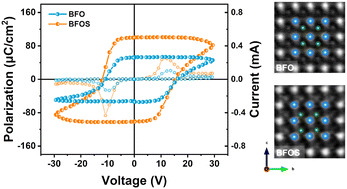Anion-induced robust ferroelectricity in sulfurized pseudo-rhombohedral epitaxial BiFeO3 thin films via polarization rotation†
Abstract
Polarization rotation caused by various strains, such as substrate and/or chemical strain, is essential to control the electronic structure and properties of ferroelectric materials. This study proposes anion-induced polarization rotation with chemical strain, which effectively improves ferroelectricity. A method for the sulfurization of BiFeO3 thin films by introducing sulfur anions is presented. The sulfurized films exhibited substantial enhancement in room-temperature ferroelectric polarization through polarization rotation and distortion, with a 170% increase in the remnant polarization from 58 to 100.7 μC cm−2. According to first-principles calculations and the results of X-ray absorption spectroscopy and high-angle annular dark-field scanning transmission electron microscopy, this enhancement arose from the introduction of S atoms driving the re-distribution of the lone-pair electrons of Bi, resulting in the rotation of the polarization state from the [001] direction to the [110] or [111] one. The presented method of anion-driven polarization rotation might enable the improvement of the properties of oxide materials.



 Please wait while we load your content...
Please wait while we load your content...